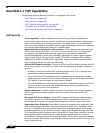
VoIP Overview
814
SonicOS 5.8.1 Administrator Guide
11. VoIP server returns phone B media IP information to phone A - Phone A now has
enough information to begin exchanging media with Phone B. Phone A does not know that
Phone B is behind a firewall, as it was given the public address of the firewall by the VoIP
Server.
12. Phone A and phone B exchange audio/video/data through the VoIP server - Using the
internal database, SonicOS ensures that media comes from only Phone A and is only using
the specific media streams permitted by Phone B.
Local Calls
The following figure shows the sequence of events that occurs during a local VoIP call.
The following describes the sequence of events shown in the figure above:
1. Phones A and B register with VoIP server - The SonicWALL security appliance builds a
database of the accessible IP phones behind it by monitoring the outgoing VoIP registration
requests. SonicOS translates between the phones’ private IP addresses and the firewall’s
public IP address. The VoIP server is unaware that the phones are behind a firewall. It
associates the same IP address for both phones, but different port numbers.
2. Phone A initiates a call to phone B by sending a request to the VoIP server - Even
though they are behind the same firewall, phone A does not know Phone B’s IP address.
Phone A initiates a call to phone B using a phone number or alias.
3. VoIP Server validates the call request and sends the request to phone B - The VoIP
server sends the call request to the firewall’s public IP address.The firewall then determines
phone B’s private IP address.
4. Phone B rings and is answered - When phone B is answered, the firewall translate its
private IP information to use the firewall’s public IP address for messages to the VoIP
server.
5. VoIP Server returns phone B media IP information to phone A - Both the called and
calling party information within the messages are translated by SonicOS back to the private
addresses and ports for phone A and phone B.
+%9
3IGNALING
-EDIA


















